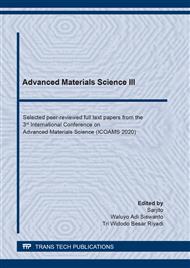[1]
Sufriadin, S. Widodo, and R. Biatong, Research Results of the Faculty of Engineering: Characteristics of Laterite Iron Ore Mineralogy and Its Potential as Raw Materials for Steel in Indonesia, The 2013 Proceedings: Research Results of the Faculty of Engineering, 7 (2013) Makasar: Hasanuddin Univ. Eng. Group Press.
Google Scholar
[2]
H. Suopajärvi, E. Pongrácz, & T. Fabritius, 2013. The potential of using biomass-based reducing agents in the blast furnace: A review of thermochemical conversion technologies and assessments related to sustainability. Renew. and Sust. En. Rev. 25 (2013) 511–528.
DOI: 10.1016/j.rser.2013.05.005
Google Scholar
[3]
H. Suopajärvi, A. Kemppainen, J. Haapakangas, & T, Fabritius, Extensive review of the opportunities to use biomass-based fuels in iron and steelmaking processes. J. Cleaner Prod., 148 (2017) 709–734.
DOI: 10.1016/j.jclepro.2017.02.029
Google Scholar
[4]
Y. Hata, H. Purwanto, S. Hosokai, J. Hayashi, Y. Kashiwaya, T. Akiyama, Biotar Ironmaking Using Wooden Biomass and Nanoporous Iron Ore. En. & Fuel. 23 (2009) 1128-1131.
DOI: 10.1021/ef800967h
Google Scholar
[5]
S. Hosokai, K. Matsui, N. Okinaka, K. Ohno, M. Shimizu, T. Akiyama, Kinetic Studyn on the Reduction Reaction of Biomass-Tar-Infiltrated Iron, En. & Fuel. 26 (2012) 7274-7279.
DOI: 10.1021/ef3013272
Google Scholar
[6]
A.N. Rozhan, R.B. Cahyono, N. Yasuda, T. Nomura, S. Hosokai, H. Purwanto, T. Akiyama, Carbon Deposition from Biotar by Fast Pyrolysis Using the Chemical Vapor Infiltration Process within Porous Low-Grade Iron Ore for Iron-Making, En. & Fuel. 26 (2012) 7340-7346.
DOI: 10.1021/ef301409f
Google Scholar
[7]
R.B. Cahyono, A.N. Rozhan, N. Yasuda, T. Nomura, S. Hosokai, Y. Kashiwaya, T. Akiyama, Catalytic coal-tar decomposition to enhance reactivity of low-grade iron ore. Fuel Proc. Tech., 113 (2013) 84–89.
DOI: 10.1016/j.fuproc.2013.03.012
Google Scholar
[8]
K., Abe, A., Kurniawan, A., Ohashi, K., Nomura, T., Akiyama, T. 2018. Ultrafast Iron-Making Method: Carbon Combustion Synthesis from Carbon-Infiltrated Goethite Ore, ACS Omega, 3, 6151−6157.
DOI: 10.1021/acsomega.8b00958
Google Scholar
[9]
Mochizuki, Y., Nishio, M., Tsubouchi, N., Akiyama, T. 2016. Preparation of Carbon-containing Iron Ore with Enhanced Crushing Strength from Limonite by Impregnation and Vapor Deposition of Tar Recovered from Coke Oven Gas, En.&Fuel. 30 (2016) 6233−6239.
DOI: 10.1021/acs.energyfuels.6b00651
Google Scholar
[10]
A. Zulkania, A. Chafidz, P. Maharani, S.A. Putri, Effect of Acidic Activated Natural Zeolite on Characteristics of Bio Oil Derived from Pinus Merkusii's Cone Pyrolysis, Key Eng. Mat'l. 818 (2019) 99-103.
DOI: 10.4028/www.scientific.net/kem.818.99
Google Scholar
[11]
K. Abe, A. Kurniawan, K. Ohashi, T. Nomura, T. Akiyama, Ultrafast Iron-Making Method: Carbon Combustion Synthesis from Carbon-Infiltrated Goethite Ore, ACS Omega, 3 (2018) 6151−6157.
DOI: 10.1021/acsomega.8b00958
Google Scholar
[12]
Y. Kashiwaya, T. Akiyama, Nanocrack Formation in Hematite through the Dehydration of Goethite and the Carbon Infiltration from Biotar, J. Nanomat'l. (2010) 235609.
DOI: 10.1155/2010/235609
Google Scholar
[13]
H. Zhao, Y. Lib, Q. Song, S. Liu, Q. Mad, L. Mae, X. Shu, Catalytic reforming of volatiles from co-pyrolysis of lignite blended with corn straw over three different structures of iron ores. J. Analyt. and Appl. Pyrol. 144 (2019) 104714.
DOI: 10.1016/j.jaap.2019.104714
Google Scholar
[14]
F. Guo, S. Liang, X. Jia, K. Peng, X. Jiang, L. Qian, One-step synthesis of biochar-supported potassium-iron catalyst for catalytic cracking of biomass pyrolysis tar, Int. J. Hyd. En. 45 (2020) 16398-16408.
DOI: 10.1016/j.ijhydene.2020.04.084
Google Scholar
[15]
R.B. Cahyono, N. Yasuda, T. Nomura, T. Akiyama, Utilization of Low Grade Iron Ore (FeOOH) and Biomass Through Integrated Pyrolysis-tar Decomposition (CVI process) in Ironmaking Industry: Exergy Analysis and its Application, ISIJ Intl'., 55, 2 (2015) 428-435.
DOI: 10.2355/isijinternational.55.428
Google Scholar


